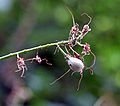Bush horse chestnut
| Bush horse chestnut | ||||||||||||
|---|---|---|---|---|---|---|---|---|---|---|---|---|

Bush horse chestnut ( Aesculus parviflora ) |
||||||||||||
| Systematics | ||||||||||||
|
||||||||||||
| Scientific name | ||||||||||||
| Aesculus parviflora | ||||||||||||
| Walter |
The Aesculus parviflora ( Aesculus parviflora ), also bush chestnut called, is a plant which the genus of horse chestnut ( Aesculus belongs). It is native to North America.
description
The bush horse chestnut is a broad- growing , deciduous shrub . The height of a solitary plant is up to 4 m. In older specimens, the growth form is significantly wider, with a stand diameter of 10 m and more can be achieved through underground runners ( stolons ). It is a shallow root with numerous fine roots. The bark is light gray to gray-brown or gray-green. The bark of the branches is more of a light or yellowish gray. The branches are round in cross section. The cross-opposite, compound leaves are fingered with five to seven partial leaves. The leaflets have a blunt tip with a wedge-shaped base and a serrated edge. The top of the leaf is dull green, the underside light green. The autumn color is yellow.
From late June to around July, it blooms in paniculate inflorescences about 10 cm in length. The white, fragrant flowers are hermaphroditic. The stamens are pink with red anthers .
The smooth, relatively thin, yellow-brown, thornless capsule fruits ripen in autumn ; their diameter is about 20 to 30 mm. The fruits are much rounder and lighter than the common horse chestnut .
Occurrence
The original home of the bush horse chestnut are the three states of Alabama , Georgia and South Carolina in the southeastern United States . In the United States, they can now also be found in Pennsylvania , New Jersey and Washington, DC

In some European gardens and parks this species has meanwhile been established as an ornamental plant , such as B. in the Fürst-Pückler-Park Bad Muskau and in the landscape park of the manor Wietzow . As a plant endangered by late frost, the bush horse chestnut prefers protected, sunny to partially shaded locations.
ingredients
The bush horse chestnut contains - like the common horse chestnut - the toxin aescin , a mixture of about 30 different saponins , and aesculin .
Various amino acids with a cyclopropane structure were isolated from the plant. Among other things, the fruits contain α- (carboxycyclopropyl) glycine. Even ester of indole-3-acetic acid are in the plant.
Pests and diseases
The bush horse chestnut is largely resistant to diseases and insect pests. The horse chestnut leaf miner cannot harm the plant.
gallery
Habit before the expulsion (beginning of April)
swell
Individual evidence
- ↑ Tree lexicon: Chestnut (Aesculus parviflora) ( Memento from December 25, 2007 in the Internet Archive ), accessed on June 3, 2008
- ↑ wildflower.org: Aesculus parviflora Walt. , accessed June 3, 2008
- ↑ Plants Database: Aesculus parviflora Walter - bottlebrush buckeye , accessed June 3, 2008
- ↑ gift Pflanzen.com: Chestnut ( Aesculus parviflora ) , accessed on June 3, 2008
- ↑ L. Fowden et al.: Cyclopropane amino acids from Aesculus and Blighia. In: Phytochemistry 8/1969, pp. 437-43.
- ↑ W. Domagalski et al .: Isolation and characterization of esters of indole-3-acetic acid from the liquid endosperm of the horse chestnut (Aesculus species). In: Plant Physiol 84/1987, pp. 1107-13. PMID 11539676
literature
- A. Chanon, P. Jourdan: Floral Development and Potential for Interspecific Hybridization of Aesculus parviflora and Aesculus pavia. In: Ornamental Plants 165-99, 1998
- R. Wyatt: Aesculus parviflora in South Carolina: phytogeographical implications. In: Bulletin of the Torrey Botanical Club 112/1985, pp. 194-5.
- C. Nägeli among others: Contributions to scientific botany. W. Engelmann (Editor), Published 1858, p. 115
Web links
- Characteristics.
- Characteristics. ( Memento from June 26, 2008 in the Internet Archive )
- Kemper Center for Home Gardening: Aesculus parviflora (engl.)
- Itis.gov: Aesculus parviflora Walt. (engl.)
- United States Department of Agriculture: Taxon: Aesculus parviflora Walter (Engl.)
- Ibiblio.org: Plants For A Future: Database Search Results Aesculus parviflora (engl.)













